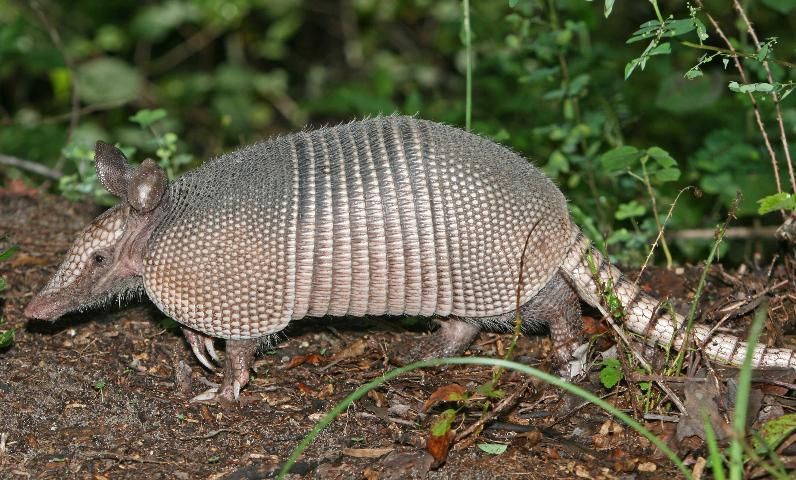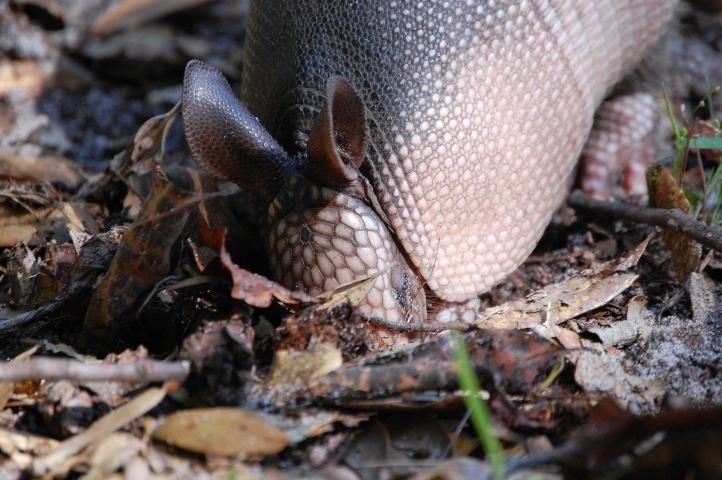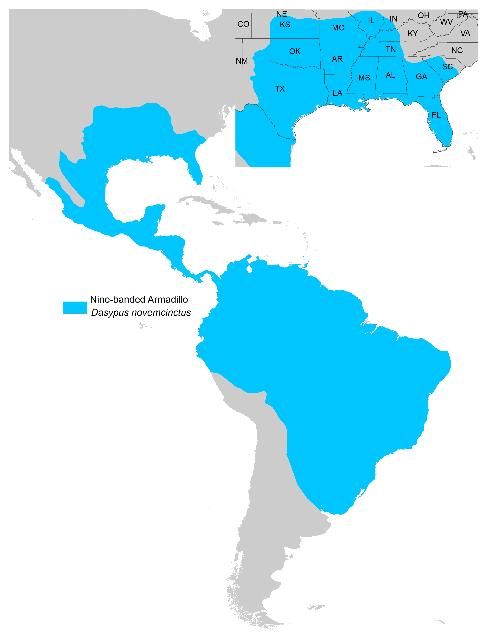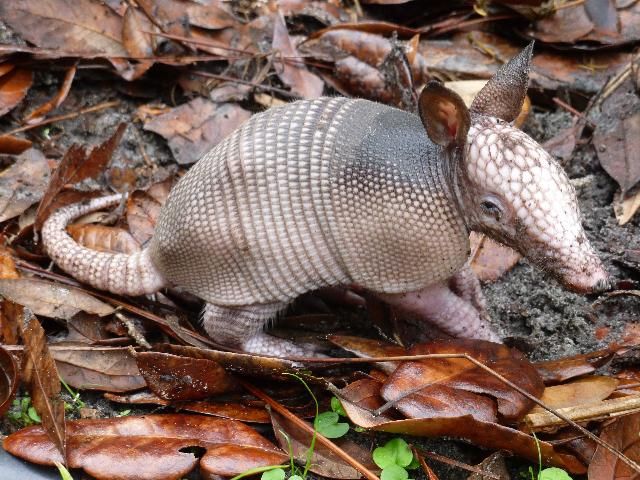The Armored Adventurer

Credit: www.birdphotos.com via Wikimedia Commons, CC BY 3.0
Breeding: summer
Habitat: grassland, oak hammock, wetland, flatwoods, scrub
Status: None
Scientific Name: Dasypus novemcinctus
Common name: Nine-banded armadillo
Habitat: All habitats, including urban areas. Prefer dense shaded cover and easy-to-excavate sandy soils.
Physical Description: A medium-sized mammal with hard, grayish-brown armor that covers its back, sides, legs, tail, and head. Adults have a combined head and body length of 15–17 inches
Weight: Average of 6–12 lbs, but can weigh as much as 20 lbs!
Reproductive Rate: Breed once annually. Gestation is typically four months long, but they exhibit delayed embryonic implantation, where they breed in the summer but do not give birth until the spring.
Lifespan: 8–12 years in the wild; some captive animals have lived >20 years.
Dispersal and Home Range: Males and females have similar home range sizes that vary by season. Summer home ranges average 15–20 acres, whereas winter home ranges average 2–8 acres. Nine-banded armadillos are unlikely to travel more than half a mile from where they are born.
Biology and Behavior: Nine-banded armadillos rarely socialize outside of the breeding season. Their protective armor is segmented and made up of ossified dermal scutes (plates of hardened skin) connected by elastic skin underneath, making them surprisingly flexible. Their undersides are soft, unarmored, and loosely covered with course hair. Nine-banded armadillos are excellent diggers and live in underground burrows up to 7 ft. deep and 20 ft. long. An individual will excavate and maintain an average of ten underground burrows within its home range. Nine-banded armadillos are insectivores that use their keen sense of smell to locate their food as their eyesight is notably poor. They forage for grubs, beetles, worms, and ants by digging shallow holes with their clawed feet and probing the soil with their long snouts. They are known to supplement their diets with fungi, fruits, tubers, seeds, the young of small mammals, and the eggs and young of ground-nesting species of birds, reptiles, and amphibians. Nine-banded armadillos have no front teeth but 28–32 teeth in rows in the backs of their mouths. They are primarily nocturnal animals but when the weather is cold they may only be active during the heat of the day. They maintain relatively low body temperatures (5℉ lower than most mammals) and low metabolic rates (50% lower than other mammals of relative size). Natural predators include bobcats, coyotes, and black bears; however, other causes of mortality include automobile collisions and some hunting by humans. As a means of defense when threatened, armadillos are capable of making an impressive 3–4 foot vertical leap into the air; unfortunately, this means they often leap into the path of an oncoming vehicle.

Credit: Mark Barrison, CC BY-SA 2.0
History: Aside from the 20 other species of armadillos in the world (all of which can be found in South America), the nine-banded armadillo's closest living relatives are sloths and anteaters. The species originated in South America and remained confined to South America until the continents of North and South America were bridged together by the formation of the Isthmus of Panama approximately 2.5 million years ago. However, it was not until the early 1850s that nine-banded armadillos managed to enter the United States from Mexico by crossing over the Rio Grande River into Texas; this crossing was likely facilitated by man-made bridges and roads. Nine-banded armadillos first appeared in Florida in the 1920s when they were introduced by humans.
Distribution: Since their arrival into the United States, nine-banded armadillos have expanded their range north and east at an average rate of 7 km/year. Their expansion will likely be limited because they do not fare well in cold or dry areas. Although not native to Florida, the species is widely regarded as naturalized and can now be found in every county.

Credit: Adapted from IUCN (International Union for Conservation of Nature) Dasypus novemcinctus. IUCN 2014.1 and Taulman and Robbins 2014
Unique Breeding: Nine-banded armadillos and their relatives in the Dasypus genus are the only vertebrates in the world known to exhibit obligate polyembryony. Polyembryony is when two or more embryos develop from a single fertilized egg; in humans this produces identical twins. Each fertilized egg will divide into quarters to produce four separate embryos; therefore nine-banded armadillos usually give birth to litters of four genetically identical young. Armadillos also exhibit delayed implantation, a reproductive strategy in which the embryo remains dormant before being implanted into the uterus.

Credit: BXGD, CC BY-NC 2.0
Did you know?
Nine-banded armadillos are good swimmers that keep their bodies afloat by ingesting air to inflate their digestive tracts and increase buoyancy.
Fast Facts
- The word armadillo means "little armored one" in Spanish.
- Contrary to popular belief, nine-banded armadillos cannot curl into a tight ball.
- Along with humans, armadillos are the only other free-living animal in North America known to be naturally infected with Mycobacterium leprae, the bacteria that causes leprosy.
How You Can Help
A few steps to reduce damage to homes and gardens from armadillos' digging:
- Water and fertilize sparingly to limit grubs and earthworms that attract armadillos.
- Remove ripe and fallen fruit.
- Install exclusion fences a minimum of 2 feet high and 18 inches deep around sensitive areas.
- If necessary, it is lawful to live-trap and relocate or humanely destroy nuisance armadillos. Contact your nearest FWC office for details.
- To learn more methods of control for Pests in and around the Southern Home see https://edis.ifas.ufl.edu/uw082.